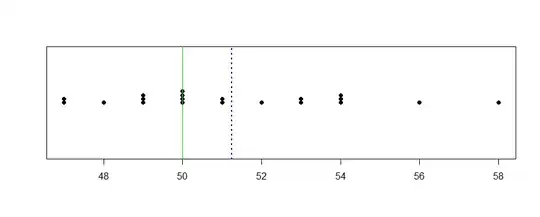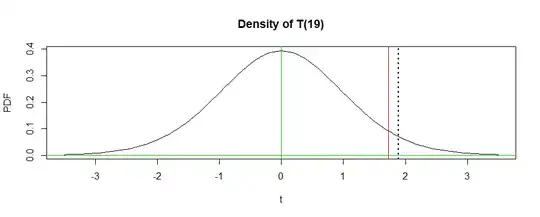Suppose you have normal data and wonder whether they are consistent
with $H_0: \mu = 50$ or whether to reject $H_0$ in favor of
$H_a: \mu > 50.$ A sample x of size $n = 20$ has mean $\bar X = 51.25,$
and standard deviation $S = 2.954.$
So the sample mean is greater than $50.$ The question is whether it is
sufficiently greater than $50$ to say that it is significantly greater'
than 50 in a statistical sense so that $H_0$ should be rejected at the 5%
level.
sort(x)
[1] 47 47 48 49 49 49 50 50 50 50
[11] 51 51 52 53 53 54 54 54 56 58
mean(x); sd(x)
[1] 51.25
[1] 2.953588
In the plot below, the value of $\bar X$ is shown as a dotted vertical line.
stripchart(x, meth="stack", pch=19)
abline(v = 50, col="green2")
abline(v = mean(x), col="blue", lwd=2, lty="dotted")

In a t test, the test statistic $T = \frac{\bar X-50}{S/\sqrt{n}} = 1.89$
takes the variability of the data into account. The critical value $c = 1.729$
of the t test cuts probability 5% from the upper tail of Student's t
distribution with DF = 19 degrees of freedom. We reject $H_0$ at the 5%
level of significance if $T \ge c = 1.729.$ So we do reject $H_0.$
qt(.95, 19)
[1] 1.729133
In R, a formal t test of $H_0$ against $H_a$ gives the following output.
t.test(x, mu = 50, alt="g")
One Sample t-test
data: x
t = 1.8927, df = 19, p-value = 0.03687
alternative hypothesis: true mean is greater than 50
95 percent confidence interval:
50.10801 Inf
sample estimates:
mean of x
51.25
Notice that there is no mention of the critical value $c.$ Instead
we have the P-value $0.037.$ This is the probability that the
t statistic exceeds the observed value $T = 1.8927.$
1 - pt(1.8927, 19)
[1] 0.03686703
In the figure below the vertical red line is at the 5% critical value $c;$ the area under the density curve to the right of this
line is $0.05.$ The dotted black line shows the value of the t statistic; the area under the density curve to the right of this line is the P-Value.

R code for figure:
curve(dt(x, 19), -3.5, 3.5, ylab="PDF", xlab="t",
main="Density of T(19)")
abline(h = 0, col="green2")
abline(v = 0, col="green2")
abline(v = 1.729, col="red")
abline(v = 1.8927, lty="dotted", lwd=2)
Here are some comments about the use of the P-value instead of the critical
value:
It makes sense for P-values to be computed in terms of values as or more extreme than the value observed. If you are willing to reject $H_0$ for
$\bar X = 51.25$ (t statistic 1.8927), then surely you would also reject for
a more extreme value such as, say $\bar X = 53.11.$
If $T \ge c,$ the 5% critical value, then the P-value is smaller than 5%.
So it is just as easy to use the P-value to decide whether to reject as to use the critical value.
If someone wants to test at the 4% level, instead of the 5% level, then the result is to reject because the P-value is also smaller then 4%. By contrast if someone wants to test at the 1% level, then $H_0$ is not rejected because the P-value exceeds 1%. (Notice that it is not necessary
to "tell" the software what significance level you have in mind; the P-value makes it possible to use any desired significance level.)
For usual levels of significance, such as 10%, 5%, 2%, 1%, 0.1%, you
can get matching critical values from most printed tables of t distributions. However, one cannot generally get exact P-values from printed tables; P-values are 'computer age' values.
My example is for a one-sided alternative. If you are using a two-sided alternative, then you have to consider the probability of
a more extreme value in either direction. Often, the P-value
gets doubled for a two-sided test.
Note: Fake data for my example were sampled using R as shown below:
set.seed(316)
x = round(rnorm(20, 52, 3))

